|
|
Expedition
Expedition | People
|
Log - August-13-2003
by Gerhard Behrens and Robert McCarthy
Previous | Next
Dive, XBT! Dive!
Robert McCarthy |
| Two days ago I mentioned that I took 3 CTD casts on the small boat just to feel useful. Well, The data from one of those casts looks like this: See fig 1 courtesy of Melissa Zweng. This graph shows temperature as a function of depth, salinity as a function of depth, and pressure as a function of depth. The CTD has a pressure sensor encased in it to measure the depth. So if I held it at a fixed depth, it would recognize that it stopped. These were short casts (obviously), and the ship can make very deep casts with the CTD on the underside of the rosette cage. But there is any easy way to get a plot of temperature with depth. Enter the XBT. X for expendable, and BT for bathythermograph. |
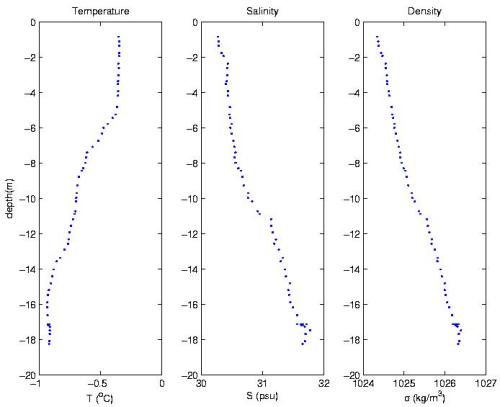 |
| The MST’s (Marine Science Technicians) on board the Healy do an XBT cast each day. Here, Suzanne Scrivens is shown making a launch, and holding one up so we can see what’s inside the tube. All it is is a torpedo shaped object that contains 760 meters of coiled, fine copper wire. They hook it up to a “gun-launcher”, and release it into the water. The water turns it on, and it measures temperature as a function of time (with its internal clock). When the XBT reaches the bottom or 760 meters, the fine copper wire breaks, and it’s gone forever. But how does it know depth? The answer is STOKES! |
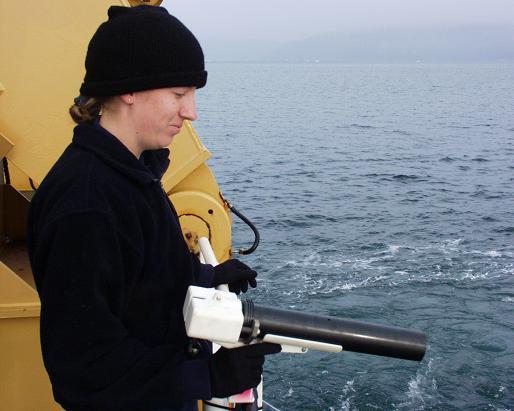 |
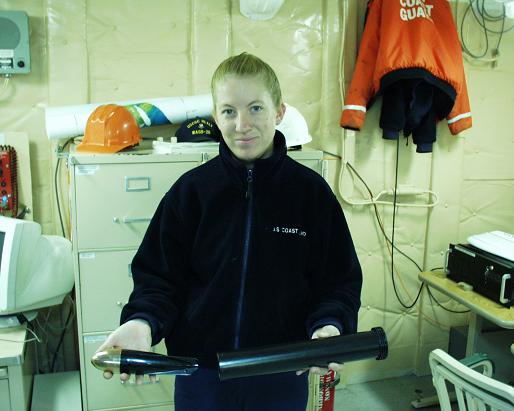 |
When an object falls through a viscous fluid, it is slowed down by a retarding force, or drag force due to resistance of the fluid. This force is a function of the shape of the object and its velocity, and is called the viscous drag force. Let’s investigate the simple case of a sphere falling through a liquid. See the diagram below. |
 |
| George Stokes in 1845 found that the magnitude of the drag force on a small, spherical object of radius r, to be |
 |
| where v is the velocity of the sphere, and eta is the viscosity of the fluid. This relationship is known as Stokes’s Law. Once terminal velocity is reached, there is a balance of the above-diagramed forces, and no more acceleration occurs. At this point, the object is traveling the fastest, but stays at this velocity. I won’t derive it here but the velocity of the ball can be calculated by balancing the forces in the above diagram, and by knowing the volume of a sphere. Skydivers experience terminal velocity when they jump out of an airplane. With arms and legs out, chest parallel to the ground, the skydiver soon reaches a constant velocity (no more acceleration). By changing their body configuration, they can accelerate to a new terminal velocity. This is how skydivers can make those formations even though they all don’t jump out simultaneously, and how they can break formation and disperse so their chutes don’t get tangled. So you can see that the object’s shape has a lot to do with the terminal velocity. |
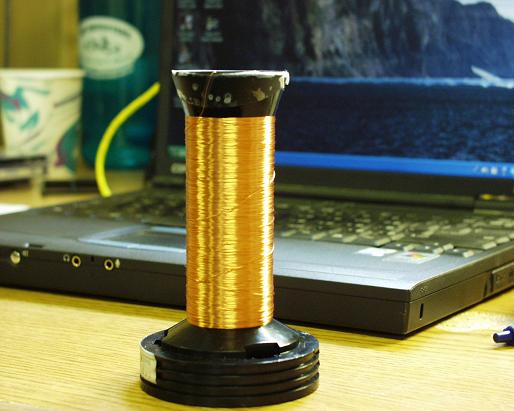 |
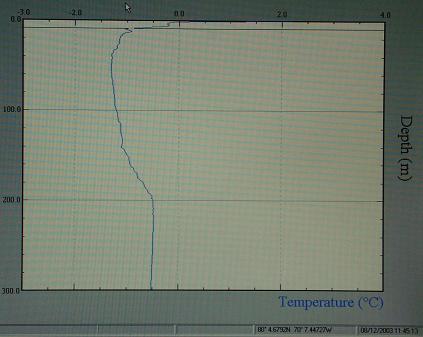 |
Well, the designers at Sippican, Inc., have measured the time these XBT’s take to reach terminal velocity, and measured the terminal velocity of the XBT’s. So they calibrated the internal time clock with a depth equivalent. The launch Suzanne made was only in water about 200 meters deep, and you can clearly see from the graph that the temperature remains constant from that depth onwards. The fine copper wire spooled completely out, and the tug from the sensor on the bottom broke the wire. Here is what the inside copper wire looks like from one where the wire broke early. |
Is There Life Down Under? You Bet
Gerhard Behrens |
| On August 9, I wrote about animal and plant life Baffin Bay, Greenland, and Ellesmere Island, even though I had not been lucky enough to see much of it. |
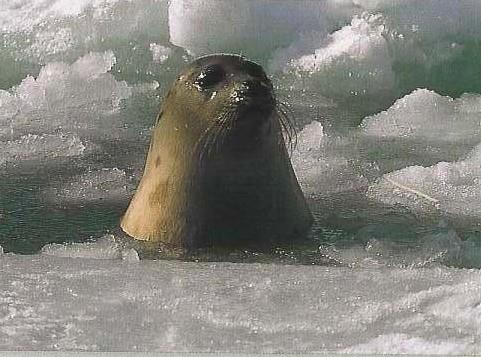
Seals come up in ice cracks for a breath. |
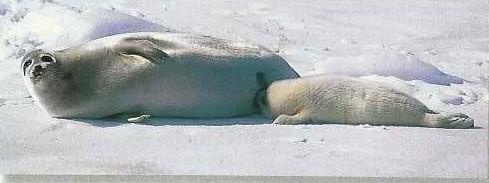
Seals nurse for 2-7 weeks. Then they’re on their own. |
How about in the waters underneath me? Again, I am surprised that I have not seen more life in the water or on the ice. The mammals of the Arctic waters are fascinating and plentiful. They are out there, even if I’m not having much luck seeing them. |
| I have seen a few black dots on the ice. And a few cute, black eyes stared back at me when I was on the small boat. So, I can claim to have seen seals. Seven kinds of seal live in the Arctic: harp, ringed, bearded, gray, hooded, ribbon, spotted. They are in the family of animals called “pinnipeds:” pinni means feather or wing; ped means foot. They live at the edges of the solid ice packs. Why? Because that’s where they can find food: fish, shrimp, and squid. Also, because that’s where the cracks (leads) of open ice form: they have to be able to come up and get air. Finally, living on the edge means they can quickly escape from its predator, the polar bear. Baby seals are born in late winter. Some are born right on the ice edge, others are born in lairs, or little tunnels, near the edge. Mothers leave their babies after nursing, between 2-7 weeks. The seal’s “grown up life” begins early! |

Walruses use their tusks to climb on to the ice. |
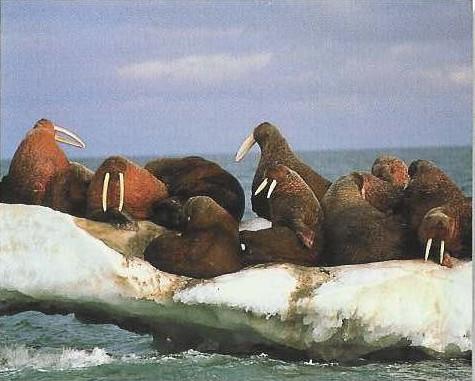
Walruses are social mammals. |
Another pinniped is the walrus. It is most famous for those big tusks. They are used to climb up onto the ice and to battle other walruses. It is also famous for its thick skin to keep it warm. Walruses are nomadic swimmers, searching for food and sleeping while they swim or float. The walrus actually stays warmer this way because the ocean temperature (0-1°C) is usually higher than the air temperature (down to -40°C). Being a bottom feeder, clams are its favorite, but it will also eat fish, shrimp, or worms that it finds at the sea floor. Walruses nurse their young for up to 2 years and love hanging out in groups, from a half dozen to hundreds! |
| Whales love the Arctic. Some migrate here in the summer to eat, and then spend the winter in warmer, sunnier places (beluga, bowhead, gray, humpback, right whale sei, sperm). Others spend their lives cruising these cold waters (bowhead and narwhal). Some have teeth, so they eat small fish and squid (sperm, beluga, narwhal). The toothed whales have only one blowhole. The other kinds of whales have baleen, which is long rows of plates like fingernails, and bristles like hairs. Baleen whales takes huge gulps of water, or sea bottom, and use the baleen to separate the water from the food. Amazingly, these immense animals eat tiny, tiny food: plankton, zooplankton, and krill. These baleen whales have two blowholes. Like walruses, whales are very social: they travel in groups (pods) and talk to each other with a variety of noises. Whales, too, take care of their young for up to two years, forming a strong bond with their child. |
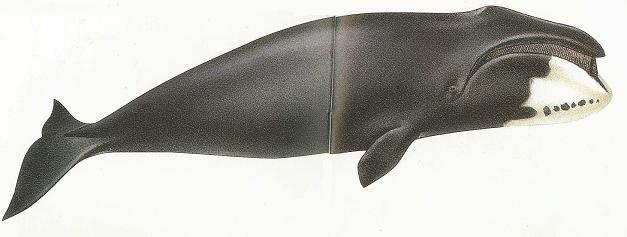
The bowhead is a baleen whale. Check out its bristle mouth. |
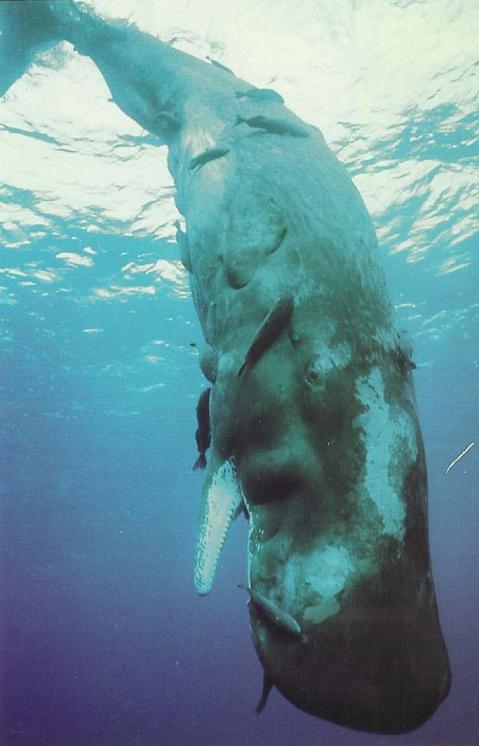
The sperm whale is a toothed whale. |
You might have asked, what is a narwhal? Barry Lopez, an author about the Arctic, says, “We know more about the rings of Saturn than we do about the narwhal.” A toothed, non-migrating whale, the narwhal lives underwater in the polar ice. That makes it hard to study and observe. It is an expert at finding openings to get a breath. It’s like a toothed whale in most ways except for “the tooth.” A unicorn whale: that’s your first thought. Only males grow this tooth (tusk), and it is used both to show off and to fight other males. |
| At the top of the food chain in the Arctic is the orca. It is looking for fish, squid, birds, seals, and whales. Either alone or in packs, it can swim up to 50 kilometers per hour (30mph) in pursuit of a meal. Like a bat, it uses echolocation to find out what’s in front of it, and then tracks it down. Best known as a killer whale, this beautiful animal lives in a group, also called a pod. Each pod not only speaks orca, but also has its own dialect of orca. Like whales and walruses, they take care of their babies for two years. |
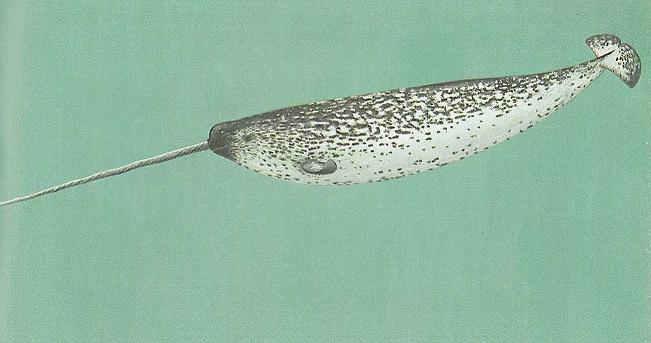
The mysterious narwhal. |

The tooth, or tusk, is used for fighting. |
I hope this “whet your appetite” about life in the Arctic waters. Learn more about these amazing mammals by going to your library or checking out a website. |
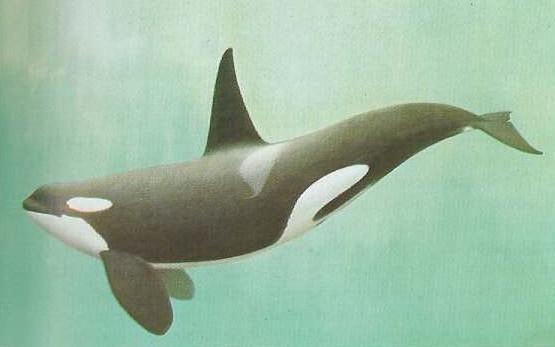
The orca is designed to swim fast. |

Orcas use echolocation to find and follow their prey. |
Photos from Whales and Dolphins, Sierra Club Books, San Francisco, 1992
Seals and Sirens, Sierra Club Books, San Francisco, 1992
Whale, Dolphins and Porpoises, Fog City Press, SF, 2000
Wildlife Explorer, International Masters Publishers, 1998 |
|
